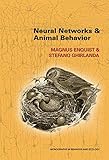Neural networks and animal behavior /Magnus Enquist, Stefano Ghirlanda.
Material type: TextSeries: Publication details: Princeton : Princeton University Press, (c)2005.Description: 1 online resource (ix, 253 pages) : illustrationsContent type:
TextSeries: Publication details: Princeton : Princeton University Press, (c)2005.Description: 1 online resource (ix, 253 pages) : illustrationsContent type: - text
- computer
- online resource
- 9781400850785
- QL751 .N487 2005
- COPYRIGHT NOT covered - Click this link to request copyright permission: https://lib.ciu.edu/copyright-request-form
| Item type | Current library | Collection | Call number | URL | Status | Date due | Barcode | |
|---|---|---|---|---|---|---|---|---|
 Online Book (LOGIN USING YOUR MY CIU LOGIN AND PASSWORD)
Online Book (LOGIN USING YOUR MY CIU LOGIN AND PASSWORD)
|
G. Allen Fleece Library ONLINE | Non-fiction | QL751.65.37 (Browse shelf(Opens below)) | Link to resource | Available | ocn864139392 |
Includes bibliographies and index.
Ch. 1. Understanding animal behavior -- Ch. 2. Fundamentals of neural network models -- Ch. 3. Mechanisms of behavior -- Ch. 4. Learning and ontogeny -- Ch. 5. Evolution -- Ch. 6. Conclusions.
How can we make better sense of animal behavior by using what we know about the brain? This is the first book that attempts to answer this important question by applying neural network theory. Scientists create Artificial Neural Networks (ANNs) to make models of the brain. These networks mimic the architecture of a nervous system by connecting elementary neuron-like units into networks in which they stimulate or inhibit each other's activity in much the same way neurons do. This book shows how scientists can employ ANNs to analyze animal behavior, explore the general principles of the nervous systems, and test potential generalizations among species. The authors focus on simple neural networks to show how ANNs can be investigated by math and by computers. They demonstrate intuitive concepts that make the operation of neural networks more accessible to nonspecialists. The first chapter introduces various approaches to animal behavior and provides an informal introduction to neural networks, their history, and their potential advantages. The second chapter reviews artificial neural networks, including biological foundations, techniques, and applications. The following three chapters apply neural networks to such topics as learning and development, classical instrumental condition, and the role of genes in building brain networks. The book concludes by comparing neural networks to other approaches. It will appeal to students of animal behavior in many disciplines. It will also interest neurobiologists, cognitive scientists, and those from other fields who wish to learn more about animal behavior.
COPYRIGHT NOT covered - Click this link to request copyright permission:
There are no comments on this title.
